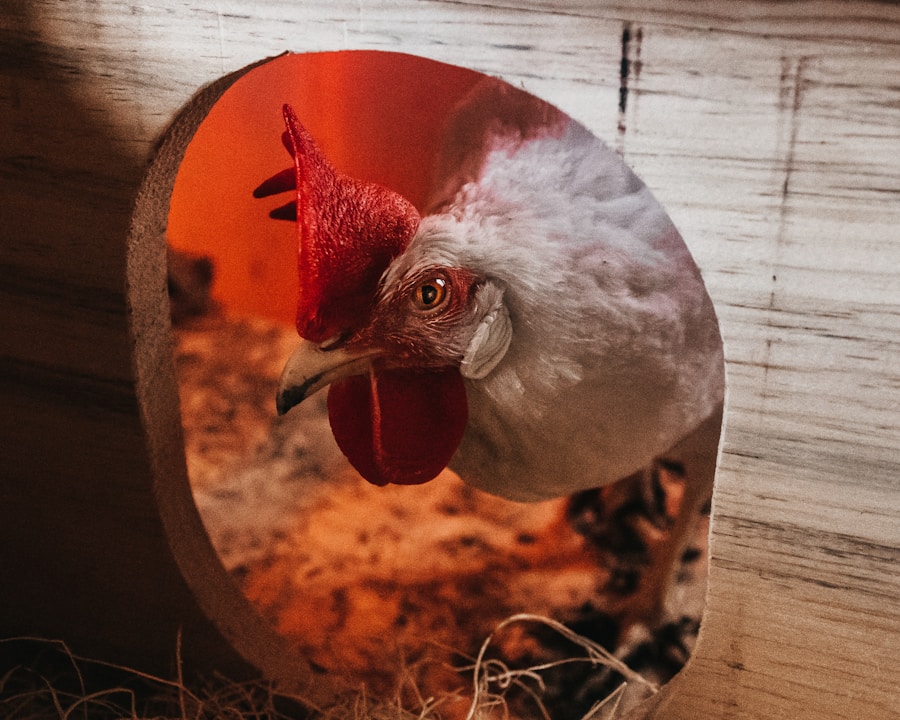Foxes are cunning and resourceful predators that pose a significant threat to your chicken coop. These intelligent animals are known for their ability to dig, climb, and squeeze through small openings, making them a formidable foe for any poultry owner. Foxes are opportunistic hunters and will not hesitate to target your chickens if given the chance. It’s important to understand the behavior and habits of foxes in order to effectively protect your flock. By recognizing the threat that foxes pose, you can take proactive measures to secure your coop and keep your chickens safe from harm.
Foxes are known for their stealthy and elusive nature, making them difficult to detect. They are primarily nocturnal hunters, which means they are most active during the night when your chickens are at their most vulnerable. Foxes are also highly adaptable and can thrive in a variety of environments, from rural farmland to suburban neighborhoods. Their keen sense of smell and sharp hearing make them skilled hunters, capable of detecting even the slightest movement or sound. By understanding the predatory behavior of foxes, you can better prepare yourself to defend your coop and protect your chickens from harm.
Table of Contents
- 1 Securing the Perimeter: Fortifying Your Chicken Coop
- 2 Predator-Proofing the Coop: Tips for Reinforcing the Structure
- 3 Implementing Deterrents: Using Scents and Sounds to Keep Foxes at Bay
- 4 Nighttime Protection: Ensuring Your Chickens are Safe After Dark
- 5 Monitoring and Maintenance: Regular Checks to Keep Your Coop Fox-Proof
- 6 Seeking Professional Help: When to Call in the Experts for Additional Protection
Securing the Perimeter: Fortifying Your Chicken Coop
One of the most effective ways to protect your chickens from foxes is to secure the perimeter of your coop. This involves fortifying the boundaries of your property to prevent foxes from gaining access to your flock. Start by inspecting the perimeter of your coop for any potential entry points, such as gaps in fencing or holes in the ground. Use heavy-duty wire mesh to reinforce the fencing around your coop, making sure to bury it at least 12 inches deep to prevent foxes from digging underneath. Consider installing an electric fence or adding a wire apron around the perimeter to further deter foxes from attempting to breach the coop.
In addition to fortifying the physical barriers around your coop, it’s important to eliminate any potential hiding spots or shelter for foxes near your property. Clear away brush, debris, and overgrown vegetation that could provide cover for foxes to hide and ambush your chickens. Keep the area around your coop well-lit and free from clutter to discourage foxes from lingering around your property. By securing the perimeter of your coop, you can create a strong line of defense against foxes and minimize the risk of a predator attack on your flock.
Predator-Proofing the Coop: Tips for Reinforcing the Structure
In addition to securing the perimeter of your coop, it’s essential to reinforce the structure itself to make it predator-proof. Foxes are skilled at finding weak points in a coop’s design and exploiting them to gain access to your chickens. Start by inspecting the walls, roof, and doors of your coop for any signs of wear or damage. Repair any holes, cracks, or gaps in the structure to prevent foxes from squeezing through or breaking in. Use heavy-duty hardware cloth or welded wire mesh to cover windows, vents, and other openings in the coop to prevent foxes from reaching inside.
Consider adding a predator apron around the base of your coop to further deter foxes from attempting to dig underneath. This involves burying wire mesh around the perimeter of the coop and extending it outward at a 90-degree angle to prevent foxes from tunneling underneath. Make sure that all doors and latches on your coop are secure and tamper-proof to prevent foxes from forcing their way inside. By reinforcing the structure of your coop, you can create a secure and impenetrable fortress for your chickens, keeping them safe from the threat of foxes.
Implementing Deterrents: Using Scents and Sounds to Keep Foxes at Bay
In addition to physical barriers and reinforcements, you can also use scents and sounds as deterrents to keep foxes at bay. Foxes have a keen sense of smell and are sensitive to certain odors that can repel them from your property. Consider using natural deterrents such as predator urine or strong-smelling plants like lavender, mint, or marigolds around your coop to discourage foxes from approaching. You can also use commercial repellents or homemade sprays made from hot peppers, garlic, or vinegar to create a barrier that foxes will find unpleasant.
Another effective way to deter foxes is by using sound-based deterrents such as motion-activated alarms, ultrasonic devices, or even a radio set to a talk station. These devices emit loud noises or high-pitched sounds that can startle and deter foxes from approaching your coop. Consider placing these deterrents strategically around your property to create a perimeter of protection against foxes. By implementing scents and sounds as deterrents, you can create an additional layer of defense to keep foxes away from your chickens and minimize the risk of a predator attack.
Nighttime Protection: Ensuring Your Chickens are Safe After Dark
Since foxes are primarily nocturnal hunters, it’s crucial to ensure that your chickens are safe and secure after dark. Start by locking up your chickens in a secure coop at night to protect them from potential predator attacks. Make sure that all doors and windows are securely closed and latched to prevent foxes from gaining access. Consider adding additional locks or reinforcements to make it even more difficult for predators to break into the coop. Install motion-activated lights around your property to deter foxes from approaching and alert you to any potential threats during the night.
Consider using guard animals such as dogs or geese to protect your chickens from foxes during the night. These animals can serve as an additional line of defense against predators and help keep your flock safe while they sleep. Train your guard animals to patrol the perimeter of your property and alert you to any signs of danger. By ensuring that your chickens are safe after dark, you can minimize the risk of a predator attack and provide them with a secure environment to roost and rest peacefully.
Monitoring and Maintenance: Regular Checks to Keep Your Coop Fox-Proof
To ensure that your coop remains fox-proof, it’s important to conduct regular checks and maintenance on the structure and perimeter of your property. Inspect the fencing, wire mesh, and other physical barriers around your coop for any signs of wear or damage. Repair any holes, gaps, or weak points in the defenses to prevent foxes from gaining access. Trim back vegetation and clear away debris around your property to eliminate potential hiding spots for predators. Keep an eye out for any signs of fox activity such as tracks, scat, or evidence of digging near your coop.
In addition to physical checks, it’s important to monitor the effectiveness of any deterrents you have in place against foxes. Replace or refresh scents and sprays as needed to maintain their potency as a deterrent. Test sound-based deterrents regularly to ensure they are functioning properly and effectively deterring foxes from approaching your property. By conducting regular monitoring and maintenance checks, you can stay one step ahead of potential threats and keep your coop fox-proof year-round.
Seeking Professional Help: When to Call in the Experts for Additional Protection
If you find that despite your best efforts, foxes continue to pose a threat to your chickens, it may be time to seek professional help for additional protection. Consider consulting with a wildlife expert or pest control professional who has experience dealing with predator management. They can provide valuable insight and advice on how to effectively deter foxes from targeting your flock. They may also be able to offer additional solutions such as trapping and relocating problem foxes or installing more advanced predator-proofing measures around your property.
In some cases, it may be necessary to invest in more advanced predator-proofing measures such as electric fencing, motion-activated sprinklers, or even hiring a professional guard animal service. These measures can provide an added layer of protection against foxes and help keep your chickens safe from harm. By seeking professional help when needed, you can ensure that you have all the tools and resources necessary to effectively protect your flock from predators like foxes.
In conclusion, protecting your chickens from foxes requires a multi-faceted approach that includes securing the perimeter of your property, reinforcing the structure of your coop, implementing deterrents, ensuring nighttime protection, conducting regular monitoring and maintenance checks, and seeking professional help when needed. By understanding the threat that foxes pose and taking proactive measures to defend against them, you can create a safe and secure environment for your chickens to thrive in peace. With careful planning and diligence, you can effectively protect your flock from the threat of foxes and provide them with a secure home where they can live free from harm.
Meet Walter, the feathered-friend fanatic of Florida! Nestled in the sunshine state, Walter struts through life with his feathered companions, clucking his way to happiness. With a coop that’s fancier than a five-star hotel, he’s the Don Juan of the chicken world. When he’s not teaching his hens to do the cha-cha, you’ll find him in a heated debate with his prized rooster, Sir Clucks-a-Lot. Walter’s poultry passion is no yolk; he’s the sunny-side-up guy you never knew you needed in your flock of friends!







